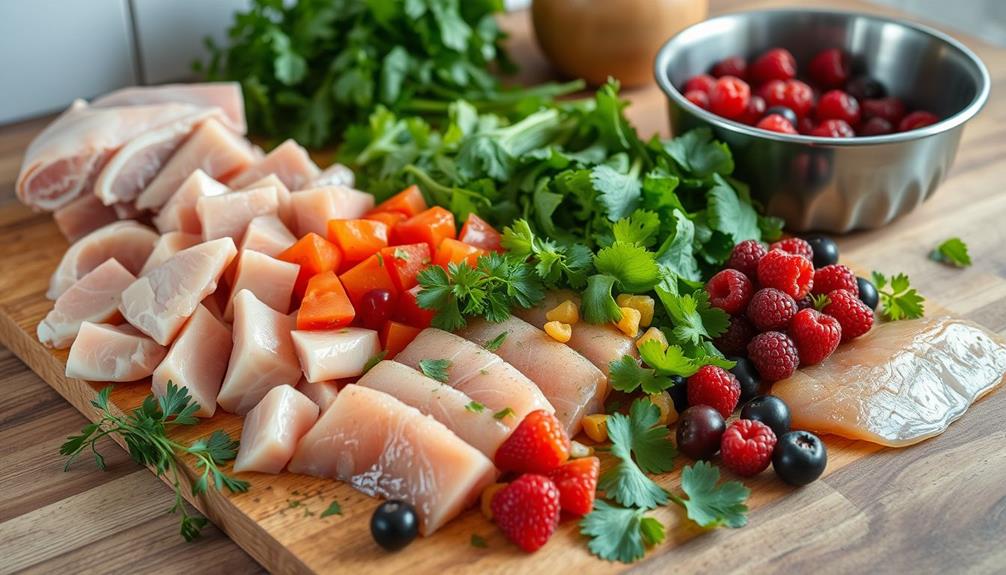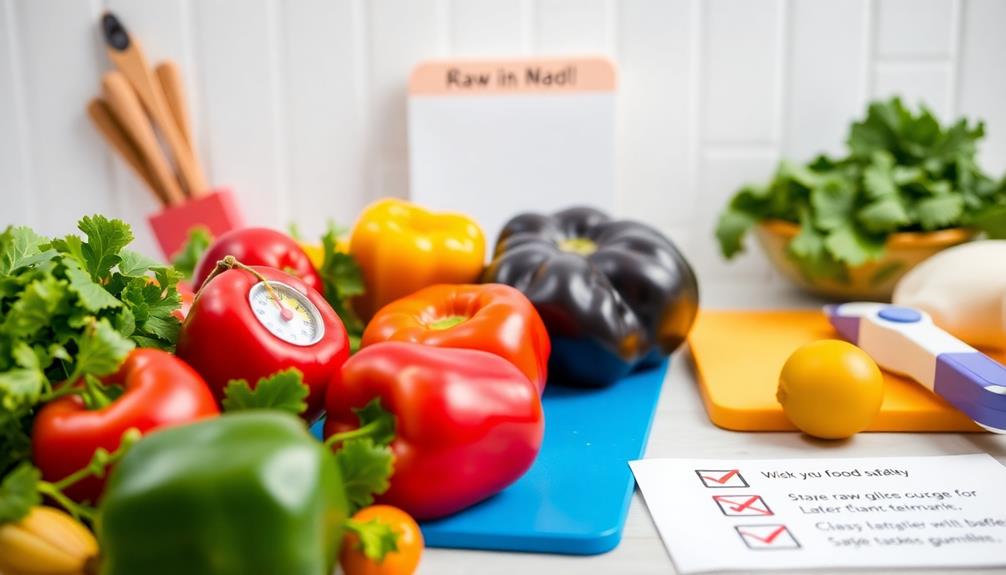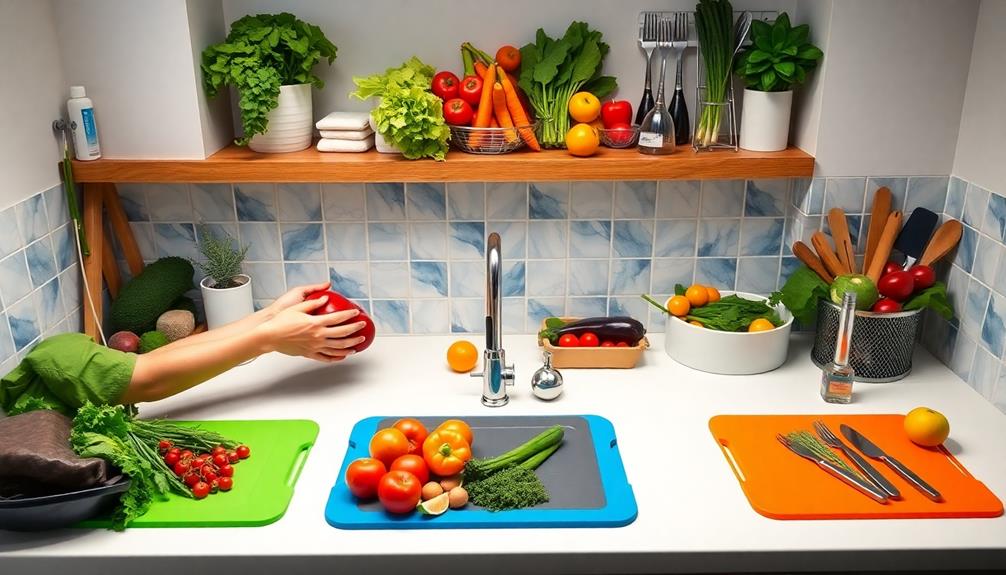Yes, you can cook raw food in an air fryer! It's a versatile kitchen appliance that cooks proteins like chicken and beef quickly and healthily, often in under 20 minutes. Just make certain to fully defrost your meat and season it well. Smaller cuts of meat and vegetables work best, achieving that crispy texture you crave. Avoid wet batters and large cuts to guarantee even cooking. By lightly brushing food with oil, you can enhance browning and flavor. If you're curious about specific recipes and tips, you'll find even more exciting possibilities waiting for you to explore.
Key Takeaways
- Yes, you can cook raw food in an air fryer, including proteins like chicken, beef, and pork, enhancing flavor through seasoning.
- Ensure raw meat is fully defrosted to achieve optimal texture and even cooking results.
- Use a meat thermometer to check doneness; chicken should reach 165°F, while pork should be at 145°F.
- Maintain at least a 1-inch space between portions in the basket for proper air circulation and cooking efficiency.
- Lightly brush raw meats with oil to prevent sticking and promote better browning during the air frying process.
Overview of Air Fryers
Air fryers have revolutionized home cooking with their innovative design and efficiency. These countertop appliances use rapid hot air circulation to cook food, mimicking the results of deep frying without excessive oil. When you use an air fryer, you'll notice how it effectively cooks raw meat, vegetables, and even frozen items, all while achieving crispy textures in under 20 minutes.
Additionally, maintaining a clean air fryer can enhance its performance, similar to how regular maintenance is essential for an air purifier's efficiency, as noted in the air purifier maintenance dos and don'ts.
The air fryer works by circulating hot air around the food, allowing for even cooking and browning. This perforated basket or tray design optimizes airflow, ensuring that every piece cooks evenly.
Typically, air fryers have a cooking capacity ranging from 3.5 to 6 quarts, making them a great option for small to medium-sized families.
Operating at temperatures between 180°F and 400°F, air fryers offer versatile cooking methods. You can fry, bake, or roast your favorite dishes with ease.
Whether you're preparing a quick weeknight dinner or experimenting with new recipes, the air fryer's efficiency and design make it an invaluable tool in your kitchen. Embrace this modern cooking method and enjoy delicious meals with less hassle!
Foods Best Suited for Air Frying
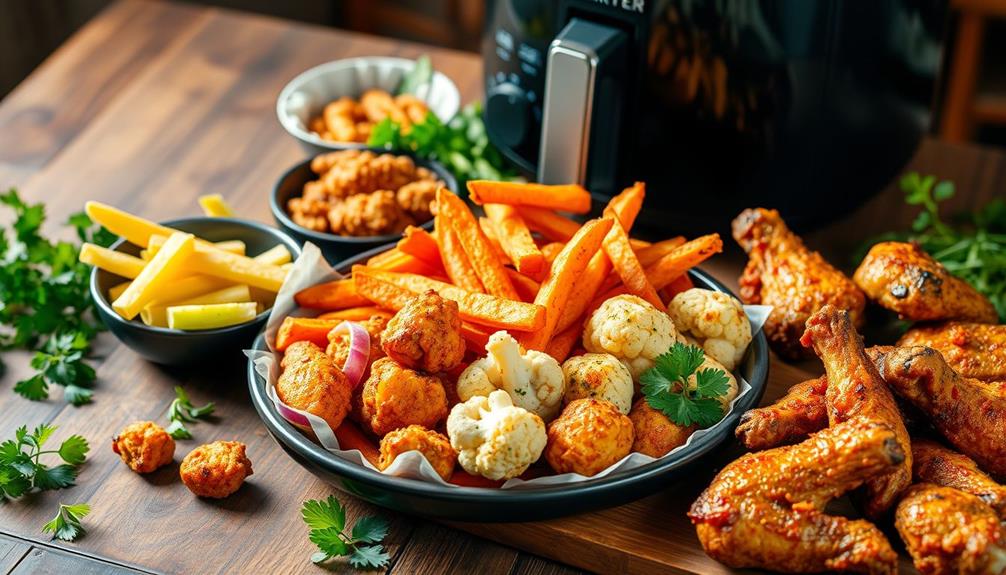
When it comes to air frying, certain foods truly shine. Frozen snacks like French fries and chicken tenders come out crispy, while smaller cuts of meat guarantee even cooking.
Additionally, you can explore easy homemade flautas which can be air-fried for a delightful twist.
You'll also love how air frying vegetables like Brussels sprouts and zucchini delivers a crunchy texture without sacrificing nutrients.
Ideal Foods for Air Frying
The air fryer is a game-changer in the kitchen, especially for those who love crispy textures without the guilt of deep frying. It's perfect for cooking a variety of ideal foods, making meal prep quicker and healthier.
Frozen foods shine in the air fryer; think French fries and chicken tenders that come out perfectly crispy without the mess of traditional frying. Additionally, incorporating natural remedies alongside conventional medications can enhance your overall health, making your meals even more nutritious.
When you want to cook raw meat, smaller cuts like chicken wings and pork chops work best. They cook evenly and quickly due to the efficient hot air circulation.
Don't forget vegetables! Brussels sprouts, zucchini, and carrots transform into deliciously roasted bites with just a touch of oil.
Even snacks fit perfectly into the air fryer. Pre-packaged cheese snacks, like cheese curds and arancini, become crispy and gooey, all while avoiding excess mess.
Plus, it's a fantastic tool for reheating leftovers, restoring their crispiness without turning them rubbery. With the versatility of an air fryer, you can explore numerous options, ensuring that you have a delightful, guilt-free meal every time.
Cooking Techniques to Use
Access the full potential of your air fryer by mastering some effective cooking techniques. This versatile appliance can transform how you prepare meals, making it easier and quicker to enjoy delicious dishes.
For instance, just like how high refresh rates enhance gaming experiences, air fryers can elevate your cooking by achieving ideal texture and flavor. Here are three techniques to take into account when using your air fryer:
- Frozen Foods: Air fryers excel at cooking frozen items like French fries and chicken tenders. They achieve a crispier texture compared to microwaving, giving you that satisfying crunch with less oil.
- Smaller Cuts of Meat: If you want to cook meat, focus on smaller cuts like chicken wings and pork chops. They cook evenly and quickly in the air fryer's confined space, ensuring tender and juicy results.
- Vegetables and Snacks: Don't forget about veggies! Air fry Brussels sprouts or bell peppers for a crispy exterior while keeping them moist inside. You can also cook pre-packaged snacks like spring rolls and mozzarella sticks, making snack time a breeze.
Benefits of Air Frying
Air frying offers numerous benefits that make it a go-to cooking method for many home chefs. One of the standout advantages is its ability to cook frozen foods like French fries and chicken tenders to a crispier perfection than a microwave ever could.
You'll love how this method requires minimal oil, promoting healthier cooking by greatly reducing fat and calorie intake. Additionally, using an air fryer can lead to energy savings, as these appliances are known for their efficiency compared to traditional ovens, aligning with energy-efficient appliances.
When it comes to meat, air fryers shine brightly. You can cook steak, chicken, and pork in under 20 minutes, making it perfect for those busy weeknights. The hot air circulation guarantees even cooking and ideal texture, especially for dry-coated items like pre-breaded foods or seasoned vegetables.
Additionally, air fryers excel at reheating leftovers, restoring their original crispiness without turning them rubbery. This not only enhances your dining experience but also cuts down on food waste.
With these benefits in mind, it's clear that an air fryer is an invaluable tool in the kitchen, allowing you to whip up delicious and healthier meals in no time. So, if you're looking to elevate your cooking game, consider investing in an air fryer!
Foods to Avoid in Air Fryers
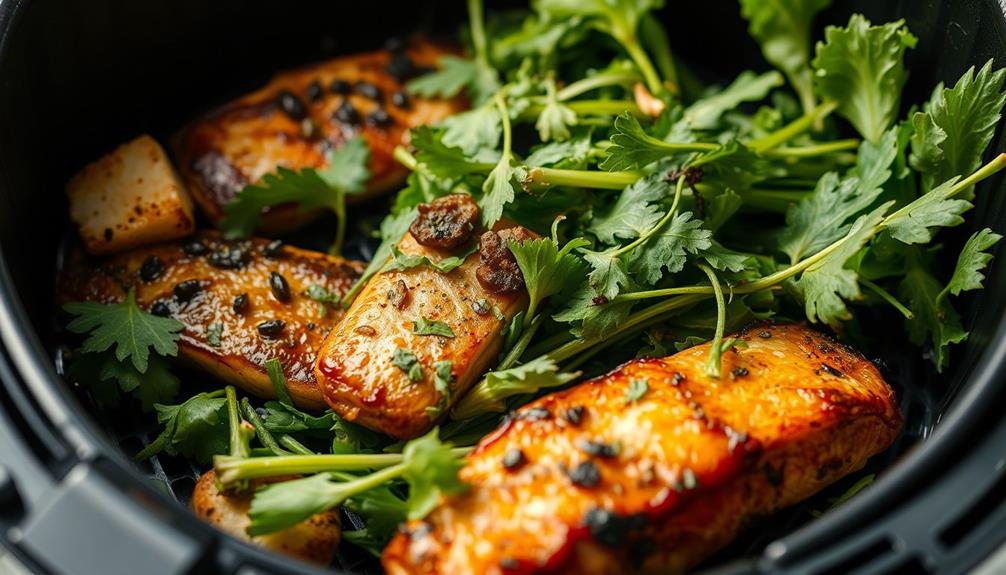
When cooking with an air fryer, knowing which foods to avoid can save you time and frustration. While this appliance is versatile, not everything cooks well in it. For example, foods with added oils or marinades can create excess smoke and mess.
Additionally, certain ingredients such as essential oils, like essential oils for toothache relief, should never be used in cooking.
Here are some foods to avoid in air fryers:
- Wet batter: Foods with wet batter don't crisp properly in an air fryer. Instead, the batter can drip through the basket, creating a mess and leaving you with soggy results.
- Raw grains: You should steer clear of raw grains like rice and pasta. Air fryers can't provide the necessary water for cooking these items effectively, which can lead to disappointing outcomes.
- Large cuts of meat: Whole roasts or large cuts of meat can cook unevenly due to limited space and compromised air circulation. Instead, opt for smaller pieces to guarantee even cooking.
Cooking Techniques for Raw Foods
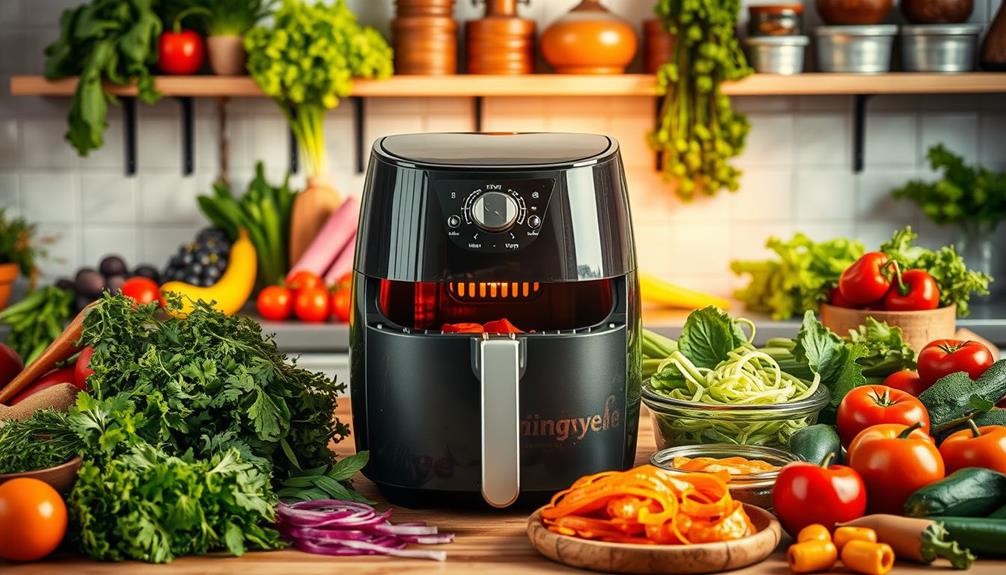
Cooking raw foods in an air fryer opens up a world of delicious possibilities, allowing you to enjoy crispy textures and rich flavors with minimal effort. You can easily cook various raw proteins, such as chicken, beef, and pork, as long as they're fully defrosted and seasoned beforehand to enhance their taste.
Understanding common financial terms can also help you budget for quality ingredients. Cooking times and temperatures will vary; for instance, verify chicken reaches an internal temperature of 165°F, while pork should hit 145°F. If you're cooking steak, aim for 125°F-130°F for medium-rare.
To achieve even cooking, flip most proteins halfway through the cooking process. However, be cautious with delicate fish fillets—leave them unflipped to prevent breakage.
Air fryers also shine when cooking raw vegetables, giving them a delightful crispy texture without needing excessive oil. Make certain not to overcrowd the air fryer basket, as this can hinder proper air circulation.
For the best results, consider lightly brushing raw meats with oil to prevent sticking and promote browning, enhancing both texture and flavor.
With these techniques, you're well on your way to mastering air frying raw foods!
Essential Tips for Air Frying
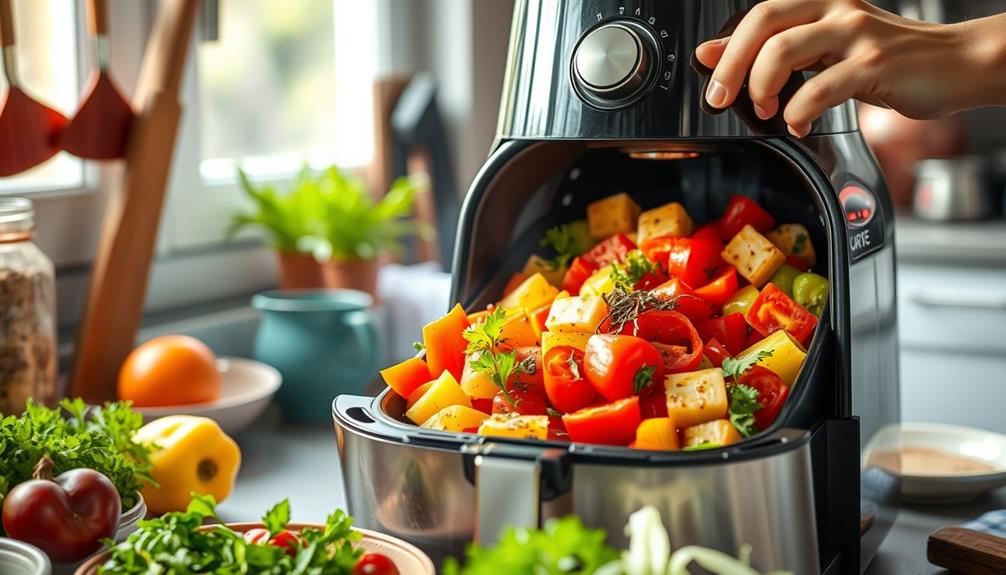
Mastering the art of air frying requires a few key strategies to assure your meals turn out perfectly every time.
Whether you're working with raw meat or vegetables, these essential tips will help you make the most of your air fryer.
For instance, understanding how different cooking methods can alter the texture and flavor of your ingredients can enhance your culinary experience, particularly when exploring various brewing methods.
- Defrost and Season: Always assure your raw meat is fully defrosted and seasoned before placing it in the air fryer. This enhances flavor and improves cooking results.
- Monitor Cooking Times: Air fryers cook quickly! Keep an eye on your cooking times, aiming for an internal temperature of 165°F for chicken and 145°F for pork and seafood.
- Space and Flip: Maintain at least a 1-inch space between portions in the air fryer basket for proper air circulation.
Flip proteins halfway through cooking to promote even cooking and browning, except for delicate fish fillets, which should remain untouched.
Creative Air Fryer Recipes

Air fryers reveal a world of culinary creativity, allowing you to whip up delicious meals in no time. You can explore a variety of air fryer recipes that transform raw food into exciting dishes. In under 20 minutes, you can enjoy crispy Brussels sprouts, juicy chicken wings, or stuffed peppers. Want something unique? Try air frying zucchini and eggplant for a tender, crunchy treat.
For your sweet tooth, don't forget about air fryer desserts! Apple chips or chocolate lava cakes showcase the air fryer's versatility beyond just savory meals. You can also experiment with different proteins like marinated shrimp or seasoned tofu, both of which achieve that perfect crispy texture.
To help you get started, here's a simple guide to inspire your cooking adventures:
| Meal Type | Example Dish | Cooking Time |
|---|---|---|
| Vegetables | Crispy Brussels Sprouts | 15 minutes |
| Proteins | Juicy Chicken Wings | 20 minutes |
| Desserts | Chocolate Lava Cake | 10 minutes |
Using an air fryer opens up endless possibilities for creating quick, delicious meals. So, immerse yourself and enjoy cooking raw food in this fantastic appliance!
Health Benefits of Air Frying
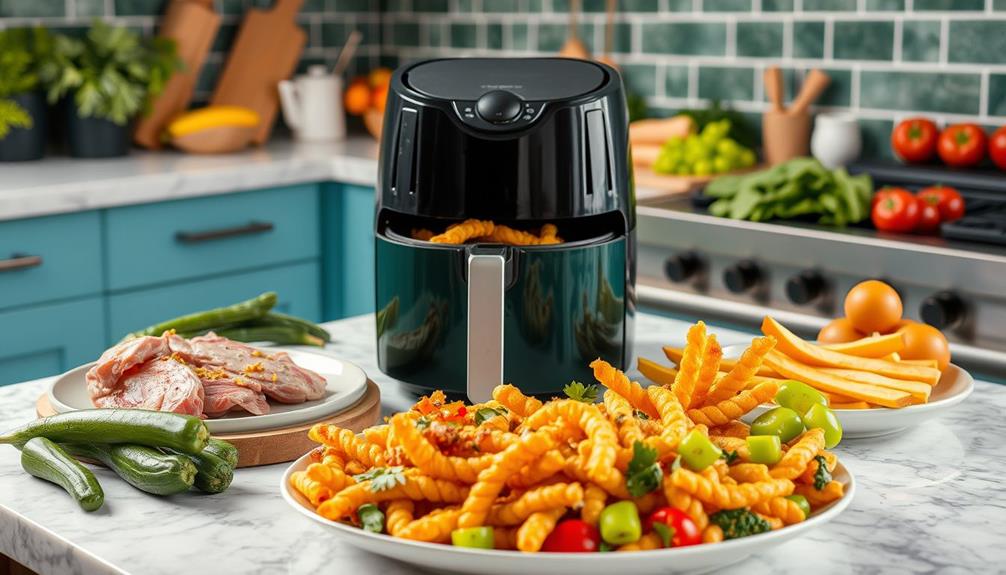
Air frying can greatly cut down the oil you use in cooking, reducing calories and making meals healthier.
This method retains more nutrients compared to traditional frying, which can lead to a higher intake of vitamins and minerals essential for well-being.
Plus, the quick cooking times help retain essential nutrients that longer methods might strip away.
By opting for air frying, you're not just making your food crispy; you're also boosting its nutritional value.
Additionally, cooking with air fryers can help prevent overcooking, which is vital for maintaining the integrity of juice diets.
Reduced Oil Usage
Reducing oil usage is one of the standout benefits of cooking with an air fryer, making it a smart choice for healthier meal preparation. With air fryers, you can enjoy deliciously crispy textures while cutting down on unhealthy fats. This cooking method aligns well with effective strategies for weight loss, as it allows for the preparation of meals that are both satisfying and lower in calories.
Here are three key advantages of reduced oil usage:
- Significant Calorie Reduction: Air fryers can cut oil usage by up to 75% compared to traditional frying methods, helping you lower your overall calorie intake from fats.
- Heart-Healthy Choices: Using just a light spritz of oil—often only a teaspoon per serving—promotes heart-healthy cooking practices while maintaining flavor.
- Enjoy Fried Favorites Guilt-Free: By utilizing an air fryer, you can savor your favorite fried foods with fewer calories and less saturated fat, contributing to improved overall health.
This means you can indulge in a variety of raw food recipes without the worry of excessive grease.
With the hot air circulation mimicking frying, you get that satisfying crunch without the added oil. Embrace the benefits of reduced oil usage, and make your meals both delicious and nutritious!
Faster Cooking Times
How can you save time in the kitchen while still enjoying delicious, healthy meals? One of the best solutions is using air fryers, which offer faster cooking times compared to conventional methods. Typically, air frying reduces cooking times by 25-30%, so you can whip up a meal in a fraction of the time. Imagine cooking raw foods in under 20 minutes—perfect for busy weeknights!
Air fryers operate by circulating hot air at temperatures between 350-400°F, which not only cooks your food quickly but also creates that delightful crispy texture through the Maillard reaction. This means your meals retain their flavor and crispiness, all while cutting down on cooking time.
Plus, because air fryers require considerably less oil, you're also making healthier choices, reducing calorie intake without compromising taste.
Another fantastic benefit of faster cooking times is that they help preserve the nutritional value of your raw foods. With less time exposed to heat, vitamins and minerals stay intact, allowing you to enjoy meals that are both delicious and nutritious.
Troubleshooting Common Issues
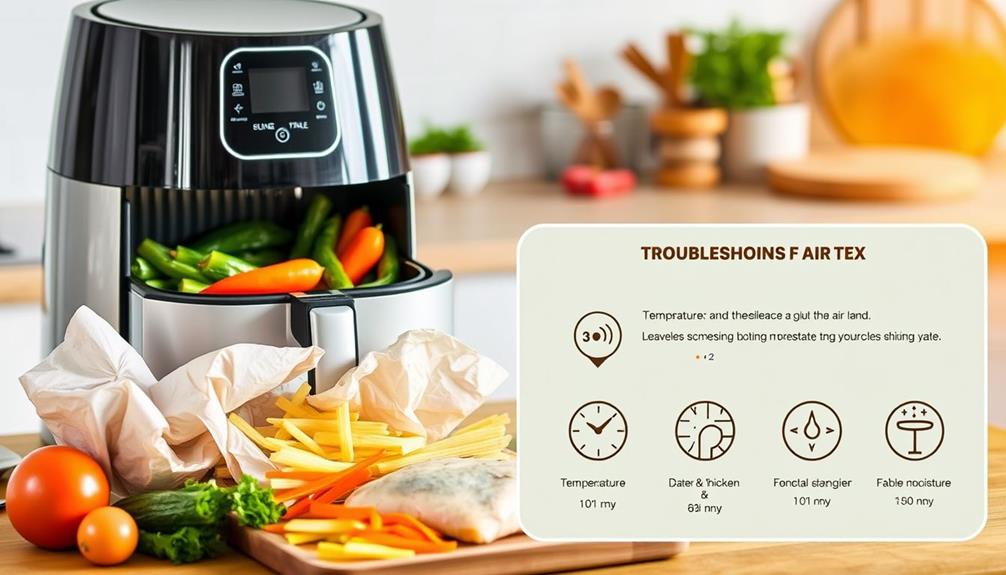
When cooking raw food in an air fryer, you might encounter a few common issues that can affect your meal's quality. Here are some tips to troubleshoot these problems and guarantee your raw meat cooks evenly:
- Defrost and Prepare: Always verify your raw meat is fully defrosted before cooking. This step is essential for achieving ideal texture and even cooking.
- Check Internal Temperature: Use a meat thermometer to monitor the doneness of your proteins. Aim for 165°F for chicken, 145°F for pork and seafood, and 125°F-130°F for medium-rare steak. This confirms that your food is both safe and delicious.
- Avoid Overcrowding: Don't overcrowd the air fryer basket. Doing so can hinder air circulation, leading to uneven cooking results. Instead, cook in batches if necessary.
Additionally, lightly brush your raw meat with about a teaspoon of oil to prevent sticking.
Remember to flip or shake your food halfway through the cooking process for even browning and crispiness.
Frequently Asked Questions
Can I Cook Raw Food in an Air Fryer?
Yes, you can cook raw food in an air fryer. Just make sure you properly defrost and season your meats, monitor cooking times, and use a meat thermometer for safe, delicious results. The air fryer is a great tool for cooking raw foods because it helps to lock in flavor and moisture while providing a crispy outer texture. Additionally, cooking raw food in an air fryer can also provide the benefits of raw food, such as preserving more nutrients and enzymes compared to traditional cooking methods. This makes it a healthy and convenient option for those looking to incorporate more raw foods into their diet.
What Foods Cannot Be Cooked in an Air Fryer?
You might think you can cook anything in an air fryer, but hold on. Foods like wet-battered items, large cuts of meat, raw grains, and delicate greens just won't turn out right. Avoid them for best results.
Is It Safe to Cook Raw Chicken in an Air Fryer?
Yes, it's safe to cook raw chicken in an air fryer, as long as it reaches 165°F internally. Preheat, season, and avoid overcrowding for even cooking. Always use a meat thermometer for accuracy.
Is There Anything You Cannot Make in an Air Fryer?
While air fryers are versatile, they can't handle everything. You won't get the right results with wet batters, large cuts of meat, or delicate greens. So, keep those dishes away to avoid culinary chaos!
Conclusion
To sum up, air fryers open up a world of culinary possibilities for cooking raw foods. With the right techniques and creativity, you can whip up delicious meals that are not only tasty but also healthier. So, why not take advantage of this versatile kitchen gadget? Experiment with different ingredients and recipes to discover your favorites. Embrace the joy of air frying and elevate your cooking game today! You might just surprise yourself with what you can create!


